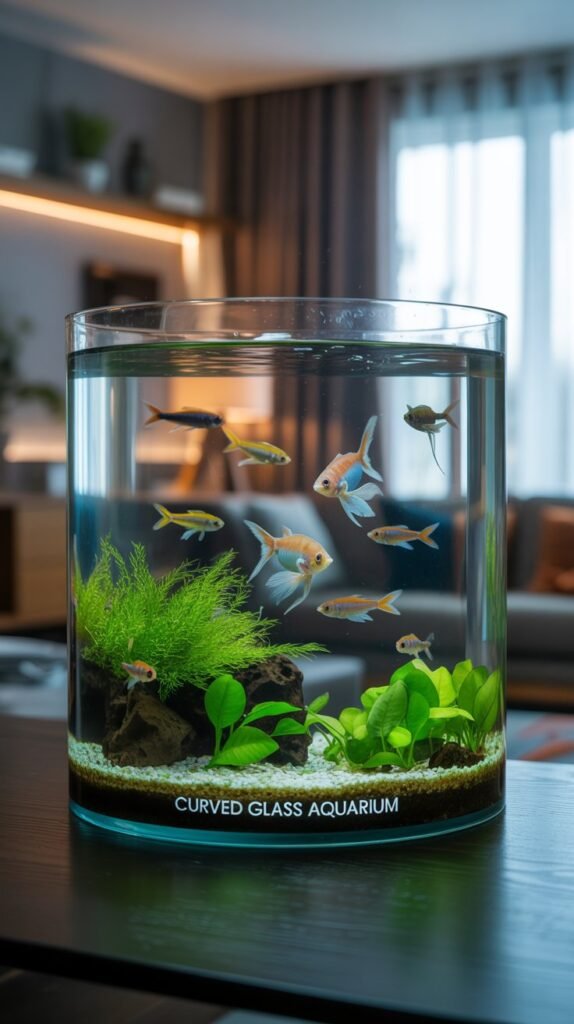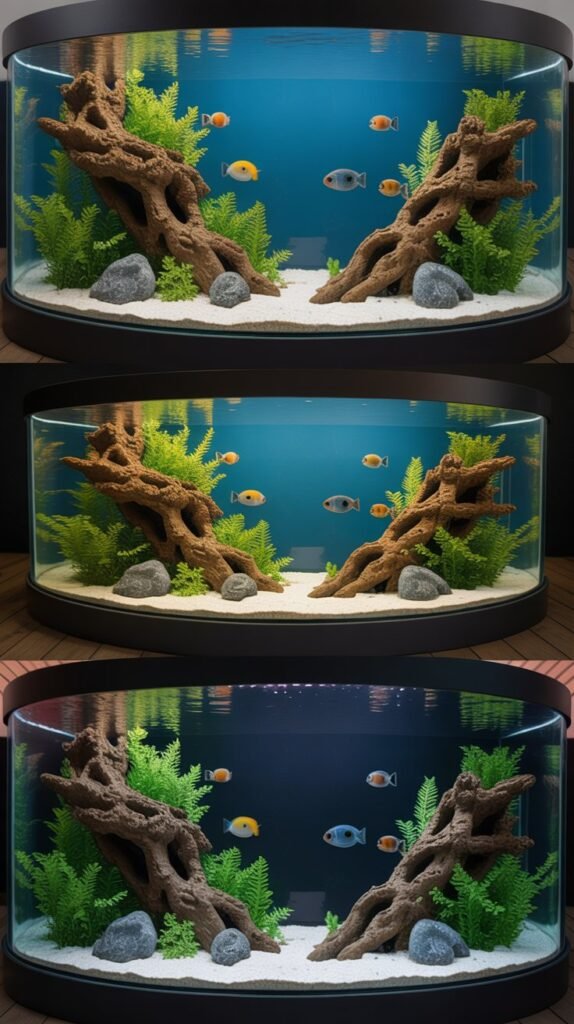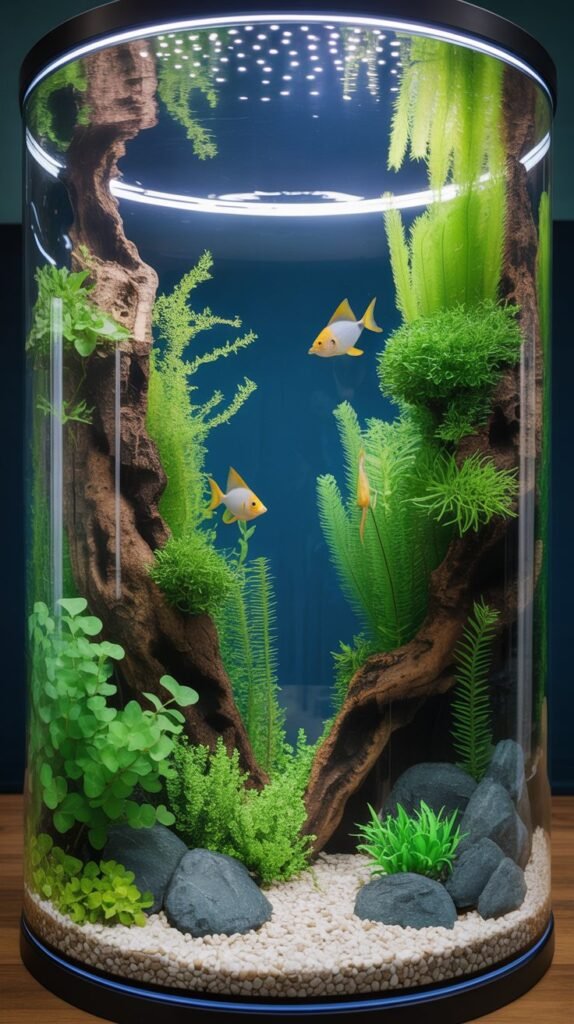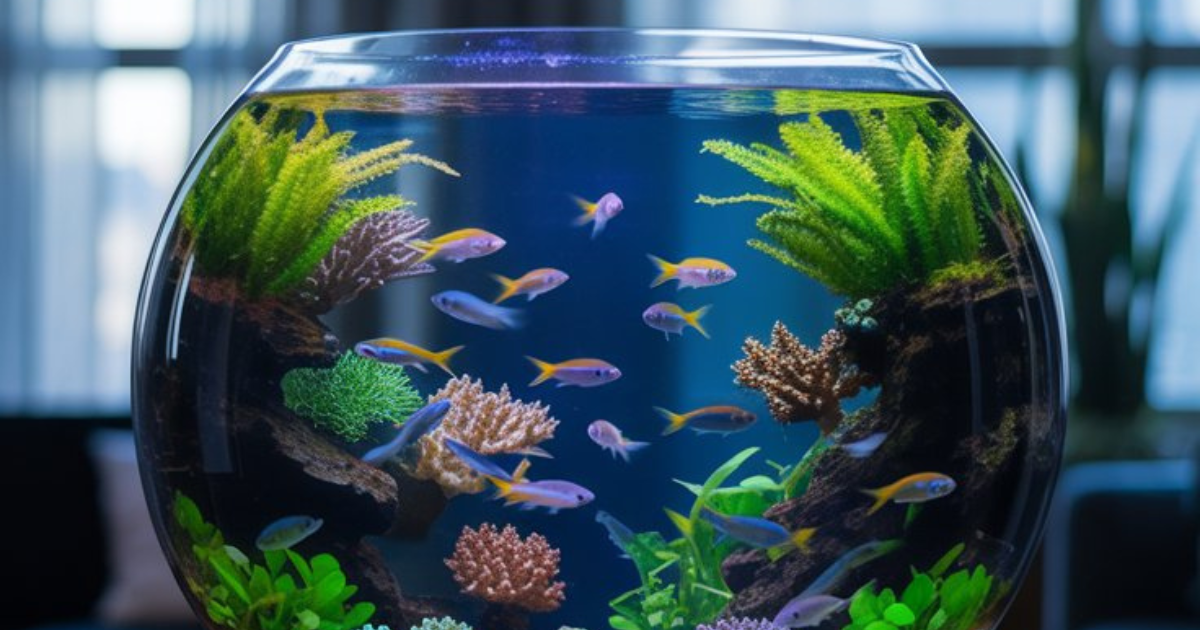Aquariums have evolved far beyond simple glass boxes that hold water and fish. Today, they are considered design statements, centerpieces, and living works of art. One of the most innovative and stylish options available to aquarium enthusiasts is the curved glass aquarium. Known for its smooth, elegant design and panoramic viewing experience, a curved glass aquarium has become a favorite among hobbyists who want both functionality and beauty in their setups.
In this comprehensive guide, we’ll explore everything you need to know about curved glass aquariums: what they are, their advantages and disadvantages, how they compare to flat-glass tanks, setup and maintenance tips, and which fish and aquascapes look best in them. By the end, you’ll understand why curved glass aquariums are increasingly popular among both beginners and experienced aquarists.
What is a Curved Glass Aquarium?
A curved glass aquarium is an aquarium where the front panel (and sometimes the side panels) are made from curved glass instead of flat panels. This design eliminates visible seams at the corners, creating a continuous, panoramic view of the aquatic environment inside.

Curved aquariums are sometimes referred to as bow-front aquariums, bent glass aquariums, or panoramic aquariums, depending on the degree of curvature and design. Unlike traditional aquariums with straight edges, the curved design makes the tank look more natural, modern, and immersive.
Why Choose a Curved Glass Aquarium?
The popularity of curved glass aquariums has been on the rise for several reasons. Here are some of the most compelling benefits:
- Panoramic View – The seamless, curved glass provides an immersive viewing experience. It feels like you’re looking into a natural aquatic world, not just a tank.
- Aesthetic Appeal – Curved tanks are visually striking and add elegance to any room or office.
- Unique Design – Unlike standard rectangular aquariums, curved glass tanks stand out and become conversation pieces.
- Ideal for Small Spaces – Many curved aquariums have compact, space-saving designs, making them suitable for desks, counters, and small apartments.
- Enhanced Depth Perception – The curved glass creates a sense of depth, making aquascapes look larger and more dynamic.
- Smooth Edges – Unlike corner seams in flat tanks, curved aquariums have a more fluid, continuous appearance.
Curved Glass Aquarium vs. Flat Glass Aquarium
When choosing between a curved glass aquarium and a traditional flat-glass aquarium, it’s important to understand the differences:
| Feature | Curved Glass Aquarium | Flat Glass Aquarium |
|---|---|---|
| Design | Stylish, modern, seamless | Traditional, box-like |
| View | Panoramic, immersive | Straightforward, flat |
| Depth Perception | Enhanced, creates illusion of space | Realistic but limited |
| Cost | Usually more expensive | More affordable |
| Maintenance | Slightly trickier to clean | Easier to clean flat surfaces |
| Best For | Display tanks, decorative aquascaping | Budget setups, large fish tanks |
Benefits of a Curved Glass Aquarium

1. Stunning Aesthetics
The biggest selling point of curved glass aquariums is their eye-catching design. They add elegance and sophistication to any environment, blending in seamlessly with modern furniture and décor.
2. Panoramic Viewing
Unlike flat aquariums that have defined edges, curved tanks provide a continuous viewing angle, which is especially appealing when placed in living rooms, waiting areas, or offices.
3. Compact and Versatile
Curved aquariums often come in nano and medium sizes, making them perfect for hobbyists with limited space who still want an attractive setup.
4. Illusion of More Space
The curved glass magnifies the view inside, giving the impression that the tank is bigger than it actually is. This effect makes aquascapes and schooling fish appear more dramatic.
5. Great for Aquascaping
Aquascapers love curved aquariums because the rounded glass enhances depth, making plants, rocks, and driftwood look more three-dimensional.
Drawbacks of a Curved Glass Aquarium
While curved aquariums are beautiful, they also have a few disadvantages:
- Higher Cost – Curved glass is harder to manufacture, so these tanks are generally pricier than standard aquariums.
- Distortion Effect – Depending on the viewing angle, curved glass can sometimes distort the image slightly.
- Harder to Clean – Cleaning the curved front panel can be trickier than cleaning flat glass.
- Limited Sizes – Curved aquariums are often smaller (nano to medium sizes), with fewer large tank options available.
- Accessory Fit – Some covers, lights, and backgrounds may not fit as easily on curved tanks compared to standard rectangular tanks.
Types of Curved Glass Aquariums
Curved aquariums come in various designs and sizes, catering to different needs:
- Nano Curved Aquariums – Small tanks (1 to 10 gallons), perfect for desktops or beginner setups.
- Medium Curved Tanks – Typically 15 to 40 gallons, great for aquascaping or small communities.
- Bow-Front Aquariums – Larger tanks (55+ gallons) with a bow-shaped front panel, offering a wider viewing area.
- Half-Cylinder Aquariums – Shaped like a half-cylinder, these provide a dramatic 180° view.
- Corner Curved Aquariums – Designed to fit into room corners, saving space while adding elegance.
Setting Up a Curved Glass Aquarium

A curved glass aquarium requires careful planning and setup to maximize its beauty. Here’s a step-by-step guide:
Step 1: Choose the Right Location
Curved tanks are display pieces, so place them in a visible spot where they can be enjoyed. Avoid direct sunlight to prevent algae growth.
Step 2: Select the Stand
Many curved aquariums come with custom stands designed to fit their unique shape. Using a mismatched stand may cause stress on the glass.
Step 3: Plan the Aquascape
Curved aquariums highlight aquascaping beautifully, so plan your layout with depth in mind. Use rocks, driftwood, and plants to create a natural, layered effect.
Step 4: Install Equipment
- Filter: Internal filters or small canister filters are commonly used.
- Heater: A compact submersible heater ensures stable temperature.
- Lighting: Choose LED lights designed for planted aquariums or to highlight fish colors.
Step 5: Add Substrate and Decor
Add gravel, sand, or aqua soil, then place hardscape elements carefully to create visual depth.
Step 6: Fill the Tank
Slowly fill the aquarium with dechlorinated water to avoid disturbing the substrate and layout.
Step 7: Cycle the Aquarium
Allow the tank to cycle for 4–6 weeks before adding fish, ensuring a stable biological environment.
Step 8: Introduce Fish and Plants
Gradually add fish, shrimp, or snails once the tank is cycled. Choose species that thrive in the tank’s size and environment.
Maintenance of a Curved Glass Aquarium
Maintaining a curved glass aquarium requires consistency:
- Regular Water Changes – Perform 20–30% weekly water changes.
- Glass Cleaning – Use curved magnetic algae scrapers for easy cleaning.
- Filter Care – Rinse filter media in tank water (not tap water) every 2–4 weeks.
- Monitor Water Parameters – Test for pH, ammonia, nitrite, and nitrate regularly.
- Aquascape Care – Trim plants and remove decaying leaves to maintain a healthy aquascape.
Best Fish for Curved Glass Aquariums
Curved aquariums highlight small, colorful, and active fish beautifully. Some great options include:
- Nano Fish: Betta fish, Guppies, Endler’s livebearers
- Schooling Fish: Neon Tetras, Harlequin Rasboras, Ember Tetras
- Peaceful Community Fish: Dwarf Gouramis, Mollies, Platies
- Shrimp & Snails: Cherry Shrimp, Amano Shrimp, Nerite Snails
- Saltwater Options (larger curved tanks): Clownfish, Gobies, Damsels
Tips for Buying a Curved Glass Aquarium
- Check Glass Quality – Opt for low-iron glass for better clarity.
- Inspect Curves – Ensure the glass curve is smooth and distortion-free.
- Go for Trusted Brands – Choose manufacturers with a reputation for strong seals and durable glass.
- Consider Accessories – Some standard lids, backgrounds, and lights may not fit; look for compatible equipment.
- Choose the Right Size – Nano curved tanks are great for beginners, while bow-front aquariums suit experienced aquarists.
Curved Glass Aquariums for Freshwater vs. Saltwater
- Freshwater Tanks – Perfect for planted aquascapes, community fish, and shrimp setups.
- Saltwater Tanks – Bow-front or half-cylinder curved aquariums provide a stunning display for corals and marine fish.
Both options are possible, but saltwater setups may require more specialized equipment such as protein skimmers and stronger lighting.
Conclusion
A curved glass aquarium is more than just a fish tank—it’s a piece of living art. With their panoramic views, enhanced depth perception, and modern design, these aquariums are perfect for aquascapers, interior decorators, and hobbyists who want something truly unique.
While they may be slightly more expensive and require careful maintenance, the aesthetic rewards are worth it. Whether you choose a nano curved tank for your desk, a medium-sized bow-front for your living room, or a large half-cylinder for a professional display, a curved glass aquarium will elevate your fishkeeping experience to a whole new level.
FAQs About Curved Glass Aquariums
Q1: Are curved glass aquariums safe?
Yes, curved aquariums are safe if built with high-quality glass and silicone. Always purchase from trusted brands.
Q2: Do curved aquariums distort the view?
Slight distortion may occur depending on viewing angle, but high-quality curved tanks minimize this effect.
Q3: Are curved aquariums more expensive?
Yes, they are generally pricier than standard aquariums due to manufacturing complexity.
Q4: Can beginners use curved glass aquariums?
Absolutely! Many curved tanks are designed for beginners and come as all-in-one kits.
Q5: Are curved aquariums harder to clean?
They can be slightly harder to clean than flat tanks, but curved magnetic scrapers make the job easy.
Q6: Do curved aquariums come in large sizes?
Most curved aquariums are small to medium-sized, but larger bow-front designs are available.
Q7: Can I use a curved aquarium for saltwater fish?
Yes, curved aquariums can be used for both freshwater and saltwater setups, provided the correct equipment is used.

